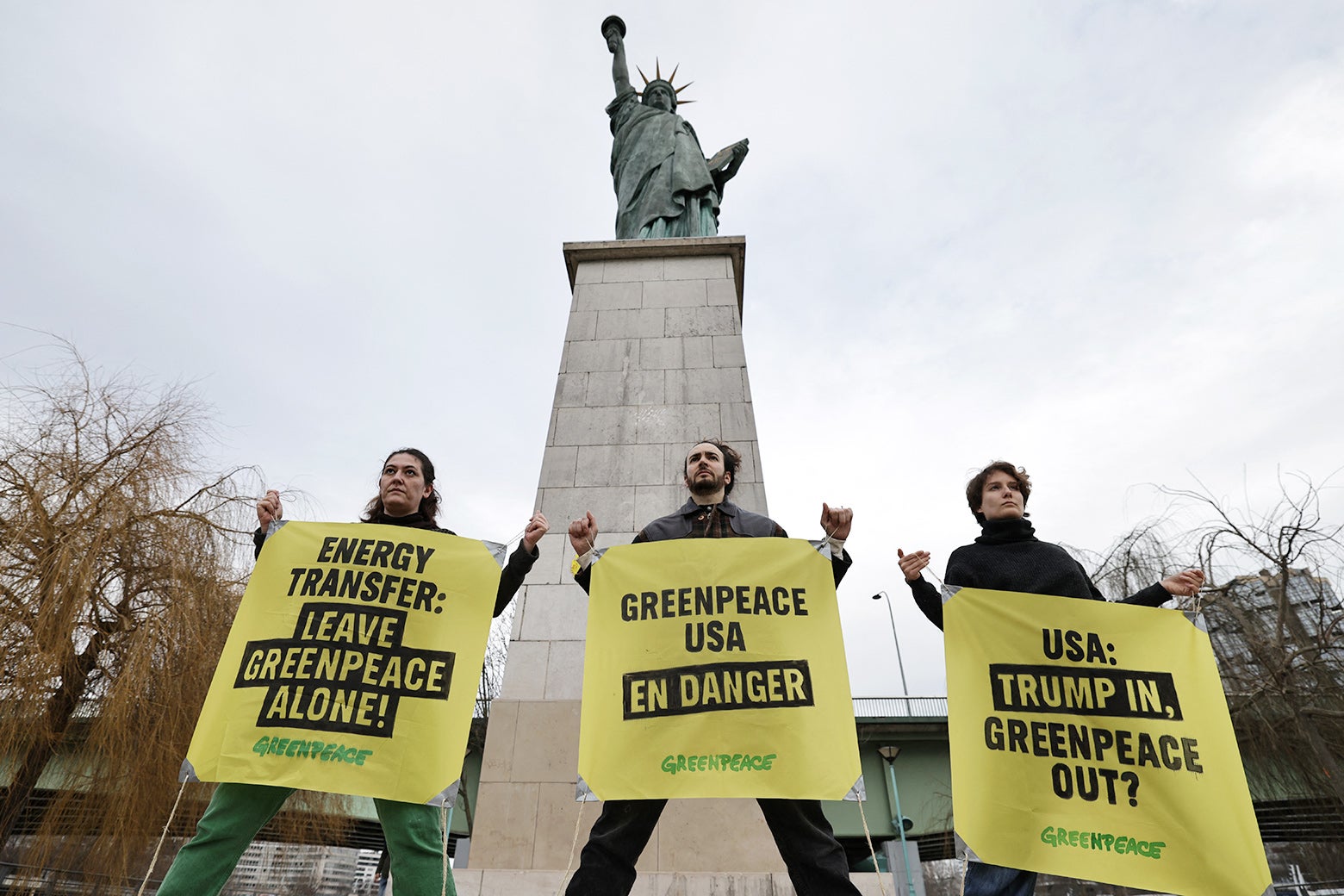Sign up for the Slatest to get the most insightful analysis, criticism, and advice out there, delivered to your inbox daily.
In the early months of the first Trump administration, the GOP megadonor Kelcy Warren, an oil billionaire whose company was building out the infamous Dakota Access Pipeline, appeared on CNBC to discuss his lawsuits against the environmental organization Greenpeace—declaring outright that he intended to “cease funding” for the advocacy group. Eight years later, it appears he may have succeeded.
Last Wednesday, after two and a half days of deliberation, the jury in a North Dakota state court ruled against three Greenpeace entities—Greenpeace USA, Greenpeace Fund, and Greenpeace International—on two of the charges brought by Energy Transfer, the parent corporation for the DAPL. Greenpeace’s domestic and international headquarters were convicted of harming Energy Transfer’s business via defamation and of engaging in tortious interference by co-signing a wider campaign for big banks to boycott Energy Transfer. The only charge the organization escaped was an allegation of illegal trespass upon the DAPL grounds. Nevertheless, those two convictions were enough to put all three Greenpeace branches on the hook for a whopping $660 million, with the majority of that burden likely falling upon Greenpeace USA, deputy legal counsel for Greenpeace USA Deepa Padmanabha told me. (In a statement outside the courthouse following the decision, Energy Transfer’s lead attorney called the ruling “the facts, not the fake news of the Greenpeace propaganda machine.”)
The Greenpeace trio will not have to hand over that cash just yet, since “we are going to be appealing this judgment to the North Dakota Supreme Court,” Padmanabha said. Still, “it’s not a secret that we don’t have $660 million.” It’s also not a secret that the Supreme Court for a heavily fossil-fueled red state is not likely to overrule the verdicts—not least since, during the trial itself, North Dakota’s top court slapped down emergency filings from Greenpeace and from trial reporters. (One, to look into a local “pink slime” propaganda campaign that Energy Transfer’s Warren may have helped fund; the second, to open up the court proceedings to the view of the wider public.)
So although the $660 million fine is steep, it isn’t the most significant or damaging aspect of this whole affair, which will inevitably carry broader consequences for any individual or organization even tangentially linked to a controversial cause. Having already catapulted off an absurd premise—that Greenpeace single-handedly organized widespread protests against the DAPL and did lasting damage to Energy Transfer’s revenue stream—the trial itself, as documented by the journalists present there, was a farce.
The 12-member jury pool was, on the whole, chock-full of oil-and-gas-linked locals who’d expressed negative views about the DAPL protests. One juror was even discovered to be an employee of a company that owns a minority stake in the DAPL. Several witnesses, Standing Rock Sioux members, and cops all testified that Greenpeace was not considered to be a leader of the rallies; indeed, many Indigenous citizens were purportedly unaware what Greenpeace was. (In a statement released during the trial, the Standing Rock Sioux Tribe’s chairwoman referred to the proceedings as “an attempt to silence our Tribe about the truth of what happened.”)
Energy Transfer’s own CEO claimed to have “no personal knowledge of Greenpeace’s involvement in the demonstrations,” per the North Dakota Monitor, and alleged that the Standing Rock Sioux had made a secret deal with a different environmental org—Earthjustice—even as he admitted he had no evidence to back up that claim. According to the climate reporter and Drilled Media editor Alleen Brown, the former head of the DAPL was paid $1,200 an hour to testify at this trial, although he no longer works for Energy Transfer and had to be flown in. And cops who’d served at Standing Rock claimed that “there was NO excessive force used against non-violent protesters,” per Brown, even though the DAPL gained national infamy because of the documented videos of police brutality against those rallygoers; that footage had spurred yet more activists to show up and protest in solidarity. In a move the Monitor deemed “unusual,” the court did not allow any recordings of the trial, including handwritten reporter notebooks. The state Supreme Court also shut down pleas to broaden public access. Independent trial monitors and attorneys helped reporters publicize the proceedings and referred to the three-week affair as “a deeply flawed trial with multiple due process violations that denied Greenpeace the ability to present anything close to a full defense.”
Make no mistake: If Greenpeace’s minimal involvement in the DAPL protests is deemed legally unacceptable, the free-speech ramifications will be drastic. Amnesty International declared that this outcome “will have a chilling effect on those campaigning to expose wrongdoing by powerful companies.” An ACLU senior staff attorney warned the Guardian, “No one will feel safe protesting corporate malfeasance.”
This ruling holds only in North Dakota for now, but it sends a message to all other litigation-happy oil companies: If you can find someone with the barest association with a specific movement and find the right place to sue them, you’ll potentially be able to bankrupt them out of further opposition. This ruling also arrives at a time when several U.S. states have outlawed oppositional action to “critical infrastructure” (e.g., pipelines), and the Trump administration grants oil-and-gas companies mass impunity for their pollution and landscape wreckage and emissions—with the help of a former North Dakota governor.
Although this event will make protests even costlier and more dangerous, it won’t stop them outright. The Standing Rock, for one, are still fighting the DAPL in court. Earlier this month, a dozen protesters who’d agitated against the Mountain Valley Pipeline were let off with only community-service hours as punishment. In Norway, Greenpeace’s local branch is teaming up with young climate activists to sue the national government over its approval of at least three new oil projects. And, as Greenpeace’s Padmanabha informed me, the trial may not have received the benefit of public view, but Greenpeace did receive the support of many allies who showed up to the courthouse throughout the ordeal: local Indigenous citizens, Unitarian church members, and even sympathetic residents of Morton County.
“I don’t think Greenpeace is well known in that community, but I did encounter many people who want to understand who we are, our Quaker founding, and our commitment to nonviolence and exercising constitutionally protected rights,” she said. “When I had the opportunity to engage in dialogue, there was a lot of support for that.”

